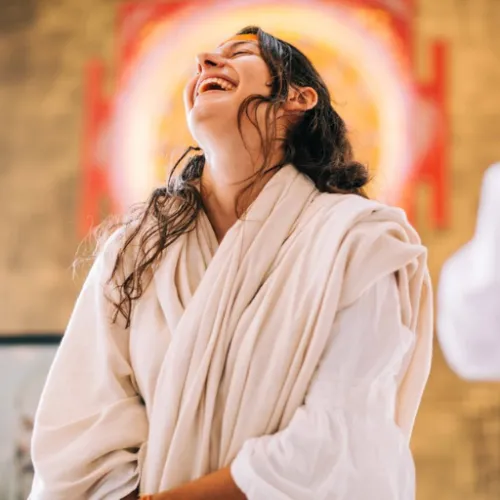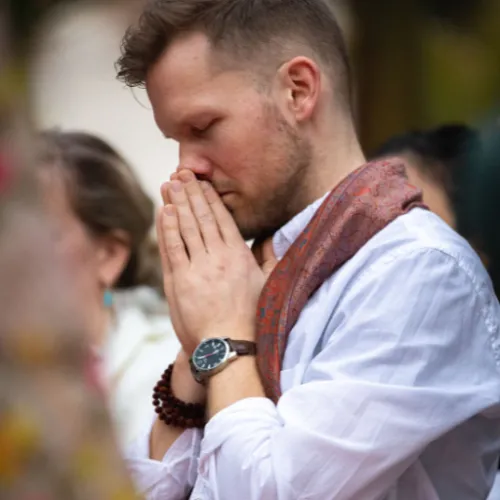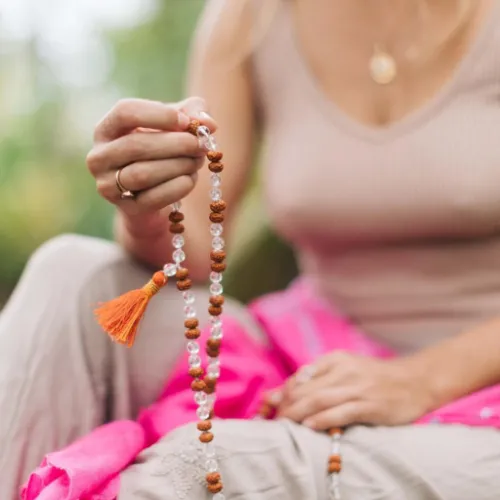


Japa means “rotate” and a japa mala is a string of beads used to focus awareness and concentration during yogic practices such as mantra meditation. The mala helps us to keep count as we move our fingers from one bead to the next. This practice counters the mind’s tendency to wander and become overwhelmed by the continuous stream of inner chatter. As we slowly move along the mala, the mind becomes rooted in that same unhurried, calm movement. Japa meditation directs awareness to a clear focus, both objectively and subjectively.
A full mala consists of 108 beads. A wrist mala consists of 27 beads. Other small, decorative beads may be used as spacers to give the mala a pattern, though one long strand is also common. In most cases, each bead is separated with a small knot so they do not touch each other. In addition, most malas have a 109th bead, the Meru (Guru bead) and are finished with a knot and tassel. The number of beads on a mala (108, 54, or 27) is significant as it represents multiples of the sacred number nine which corresponds to, among other things, the number of planets in Vedic astrology and the number of months a baby develops in the womb. The number nine represents a multiple of another sacred number, three, the trinity. With awareness, one will notice the numbers nine and three evident in many aspects of science, the natural world, and spiritual practices around the world. A mala is a constant reminder of and connection with these sacred numbers.
Malas are made from wood, seeds, semi-precious gemstones, or precious gemstones and strung with a durable thread or cord. Gemstones embody intense concentrations of energy. They support transformation and realization by supporting the specific and unique needs of an individual. The gemstone itself does not offer what a person needs, but rather it offers a tool for shifting in that direction.
Additionally, two varieties of seeds and of wood are commonly used for malas. The Bodhi seed is symbolic of the Buddha, who attained enlightenment under the Bodhi tree. The Rudraksha seed represents the eye of Shiva. Both Rosewood and Sandalwood beads are also common.
A mala itself is not a holy or magical artifact. It is a sacred tool for yoga practice in the same way asana, food, and music or other sound vibrations are tools for one’s yoga practice. A mala’s significance and power are derived from the intention and sincerity of the user. With sincerity, meditation with a mala fosters devotion and the mala becomes a portable sacred space that is a physical representation of your practice and intentions. The benefits of a mala practice are numerous and as unique as the individual practitioner.
Malas, while often stunning and eye-catching, are not accessories or jewellery and, as such, are worn under clothing so the mala is touching the heart. Malas are to be cared for and placed in loving, sacred spaces, such as your altar, when you are not using or wearing them. And dipping a mala in the Ganga River is an especially sacred act.
So, how to start meditating with a mala?
To practice japa meditation, hold your mala in either hand with the beads between your middle finger and thumb. The middle finger represents Saturn, the planet of meditation and deeper awareness. The thumb represents one’s true Self. Hold your mala gently and with respect. Move to a new bead upon each breath or recitation of your mantra. When you arrive at the guru bead, flip the mala 180 degrees and continue in the opposite direction rather than moving over the guru bead. The guru bead represents Guru. It represents the end that becomes the beginning and the beginning that becomes the end.
And be sure to select a mantra that is special to you. You may choose to recite the mantra aloud or silently, or begin aloud and transition to silence. Each recitation and movement of mala beads should be in rhythm and harmony. You may chant 108, 54, or 27 times (full, half, or quarter mala). For tapas, set an intention to complete 11,000 or 21,000 rounds of the mantra within a specific time period. Do the math to calculate how many malas you will need to do each day.
And when to do a japa practice?
If your mind feels cluttered or you are experiencing old emotions or patterns rising up, you can do a japa practice. It will anchor you in the present moment and start to create new synapses in the brain, propelling you forward on a more positive trajectory, especially when chanted with love and devotion.
But a japa practice is always beneficial as it calms the mind and allows you to access support from nature. And a consistent japa practice imbues us with the qualities that mantra invokes.
Also, a great thing about japa is that it is a very versatile practice that can be done anywhere, at any time. You can do it while on a walk or on the bus or as you lie in bed.
And if you want to start today, you can use a mantra for Shiva, OM NAMAH SHIVAYA. This is a very powerful mantra that guides you to experience deep inner silence.
FAQs
Q1: What is the best mantra for Japa meditation?
A1: Any mantra given by a teacher or one that resonates with your heart can be powerful. Common mantras include “Om Namah Shivaya” or “Om Mani Padme Hum.”
Q2: How many repetitions should be done in Japa practice?
A2: Traditionally, 108 repetitions are practiced using a mala. However, even smaller counts done consistently bring benefits.
Q3: Can Japa be practiced without a mala?
A3: Yes, Japa can be practiced mentally or verbally without a mala, though malas help maintain focus and count.
Q4: What are the benefits of Japa meditation for mental health?
A4: Japa reduces stress, improves concentration, balances emotions, and creates a deep sense of calmness.
Q5: How does Japa connect with Bhakti Yoga?
A5: Japa is an expression of devotion. Repeating a divine name or mantra cultivates love, surrender, and connection with the higher self or deity.

To learn more mantras, visit the Mantra Lab on Sattva Connect. Your Support to an Awakened Life!
There are beautiful japa practices on the platform, for example the Shri Sadhana with Annemarie or 40 day Sadhana with Saraswati to cultivate detachment.





















































































